
Euphorbia is a very large and diverse genus of flowering plants, commonly called spurge, in the spurge family (Euphorbiaceae). "Euphorbia" is sometimes used in ordinary English to collectively refer to all members of Euphorbiaceae, not just to members of the genus. Some euphorbias are commercially widely available, such as poinsettias at Christmas. Some are commonly cultivated as ornamentals, or collected and highly valued for the aesthetic appearance of their unique floral structures, such as the crown of thorns plant. Euphorbias from the deserts of Southern Africa and Madagascar have evolved physical characteristics and forms similar to cacti of North and South America, so they are often incorrectly referred to as cacti. Some are used as ornamentals in landscaping, because of beautiful or striking overall forms, and drought and heat tolerance.

Euphorbia mellifera, the Canary spurge or honey spurge, is a species of flowering plant in the spurge family Euphorbiaceae, native to Madeira and the Canary Islands. It is an evergreen shrub or tree growing to 2.5 m (8.2 ft) tall and broad, with narrow leaves up to 20 cm (8 in) long. In spring it produces brown, honey-scented flowers.

Sphaeropteris cooperi, synonym Cyathea cooperi, also known as lacy tree fern, scaly tree fern, or Cooper's tree fern, is a tree fern native to Australia, in New South Wales and Queensland.
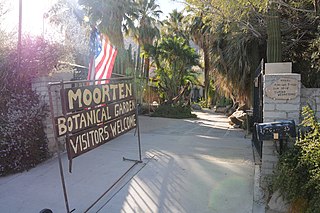
The Moorten Botanical Garden and Cactarium is a 1-acre family-owned botanical garden specializing in cacti and other desert plants, located at 1701 South Palm Canyon Drive, Palm Springs, Riverside County, California, United States. It is in the Colorado Desert ecosystem.

Ganna Walska Lotusland, also known as Lotusland, is a non-profit botanical garden located in Montecito, near Santa Barbara, California, United States. The garden is the historic estate of Madame Ganna Walska. The County of Santa Barbara restricts visitation via a conditional use permit: Lotusland botanic garden is open to the public by advance reservation only, with walking tours 1½ to 2 hours long.
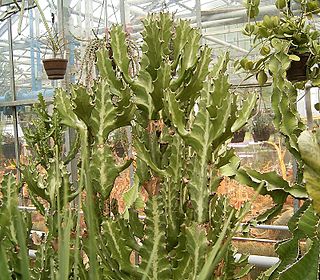
Euphorbia lactea is a species of spurge native to tropical Asia, mainly in India.
Candelabra tree can refer to:
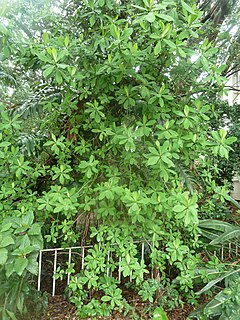
Euphorbia cupularis, referred to by the common name dead-man's tree is a succulent tree or shrub of the spurge family, Euphorbiaceae. It is found in South Africa and Swaziland.
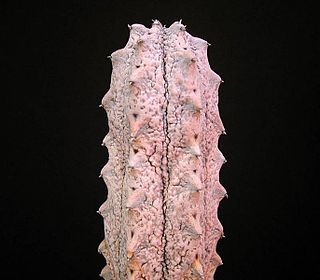
Euphorbia abdelkuri is a species of plant in the family Euphorbiaceae. It is endemic to Abd al Kuri, an island south of Yemen. Its natural habitat is rocky areas. The Latex of the plant is toxic.

Euphorbia arbuscula is a species of plant in the spurge family (Euphorbiaceae). It is endemic to the archipelago of Socotra in Yemen. Its natural habitats are subtropical or tropical dry forests and subtropical or tropical dry shrubland.
Euphorbia jamesonii is a species of plant in the family Euphorbiaceae. It is endemic to Ecuador. Its natural habitats are subtropical or tropical moist montane forests and subtropical or tropical dry shrubland.

Euphorbia leuconeura is a species of flowering plant in the family Euphorbiaceae. Its common name is Madagascar jewel. It is endemic to Madagascar where its natural habitat is forest undergrowth in rocky areas. It can grow to a height of 1.8 m (6 ft), as a branching small tree, and propagates by shooting its seeds several feet into the air. It is threatened by habitat loss.
Euphorbia quitensis is a species of plant in the family Euphorbiaceae. It is endemic to Ecuador. Its natural habitat is subtropical or tropical moist montane forests.

Salvia candelabrum is a species of flowering plant in the family Lamiaceae, native to Spain. It is a woody-based perennial growing to 100 cm (39 in), with woolly grey-green leaves that resemble those of the common sage, S. officinalis, and emit a similar scent when crushed. In summer it bears violet-blue flowers on branching stems held high above the foliage.

The Euphorbiaceae, the spurge family, are a large family of flowering plants. In common English, they are sometimes called euphorbias, which is also the name of a genus in the family. Most spurges such as Euphorbia paralias are herbs, but some, especially in the tropics, are shrubs or trees, such as Hevea brasiliensis. Some, such as Euphorbia canariensis, are succulent and resemble cacti because of convergent evolution. This family occurs mainly in the tropics, with the majority of the species in the Indo-Malayan region and tropical America a strong second. A large variety occurs in tropical Africa, but they are not as abundant or varied as in the two other tropical regions. However, the Euphorbiaceae also have many species in nontropical areas such as the Mediterranean Basin, the Middle East, South Africa, and the Southern United States.
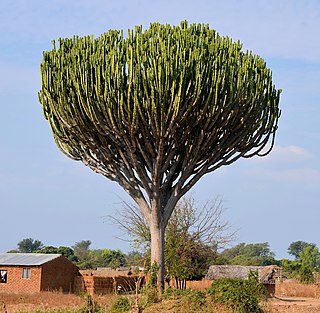
Euphorbia ingens is a species of flowering plant in the family Euphorbiaceae. It is native to dry areas of southern Africa. It is popularly known as the candelabra tree or naboom, and its milky latex can be extremely poisonous, and a dangerous irritant.
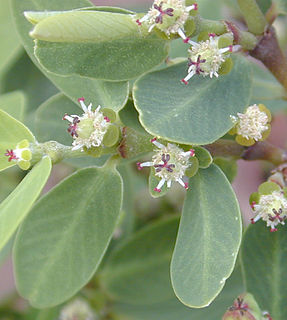
Euphorbia celastroides is a flowering plant in the family Euphorbiaceae. It is referred to by the common name 'akoko by Hawaiians, and is a species of spurge closely related to the poinsettia. This species develops into a round-shape shrub. This species is endemic to the Hawaiian Islands.

The North-West University Botanical Garden on the Potchefstroom Campus of the North-West University (NWU) is the only botanical garden in the North West Province of South Africa. The Garden spans just under three hectares and is open to the public.
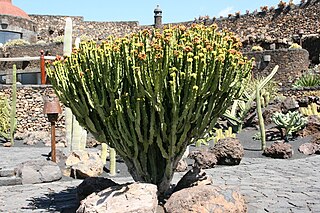
Euphorbia abyssinica, commonly known as the desert candle or candelabra spurge, is a species of plant in the family Euphorbiaceae. E. abyssinica is endemic to Ethiopia, Somalia, Sudan and Eritrea. It was first described in 1791, by the German botanist Johann Friedrich Gmelin. In its native habitat, it can grow up to 10 m (33 ft) tall. The woody stem is used for firewood and as timber in roofing, furniture and other items, and the sap is used in traditional medicine. It is also cultivated as an ornamental house plant.

Adromischus cooperi is a species of succulent plant from the family Crassulaceae. The genus name Adromischus comes from ancient Greek adros and mischos, and the species name from James Graham Cooper, an American naturalist and surgeon. The plant is endemic to the Eastern Cape of South Africa.




















